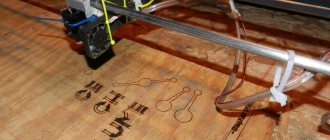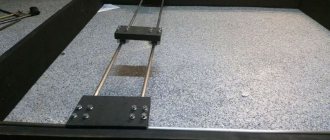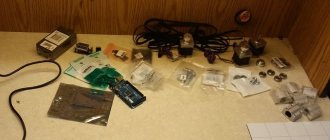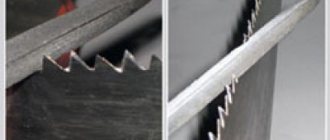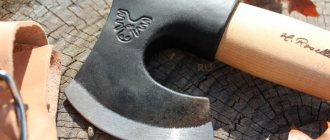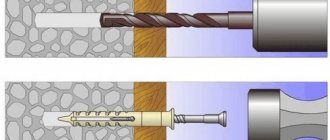Purpose and principle of operation of the engraver
The engraver, although universal, is still intended to perform highly specialized work.
Its most common type is an engraving machine with an electric drive, the working element of which is removable attachments that exert a mechanical effect on the surface being processed.
The laser version of this tool does not directly contact the part, but burns the material with a high-energy beam.
This tool does:
- Engraving on stone, wood, metal and even glass. Similar operations are carried out in the manufacture of, for example, souvenirs. The corresponding attachment is clamped into the collet and the engraver can be used to draw on various materials.
- Removing coatings, such as sanding paint and sanding small items or hard-to-reach areas using felt pads, sandpaper and abrasive wheels.
- Making thin cuts, precision cutting in wood and metals. The tool is common among jewelers, as it allows for precise, accurate processing of materials.
In addition, the engraver applies markings, in particular on metal parts, makes seals and impact stamps, and cliches.
Mechanical and laser engraving is used by advertising agencies to apply text and graphics to a variety of materials.
TOP 7 best hand engravers, up to 5,000 rubles
Pro'sKit PT-5501G
A good engraver, it comes with 40 attachments and a flexible shaft. Motor power 135 W. Disc rotation speed from 10,000 to 32,000 rpm. Adjusting the engine speed.
VORTEX G-160GV new
A good model for a beginner.
Fits comfortably in the hand. Users note that there is runout in the flexible shaft and consumables of poor quality. Power 160 W. Rotation speed up to 30,000 rpm. There are few attachments included.
BISON ZG-160EK
Convenient engraver for home use.
Power 160 W. Maximum rotation speed 35,000 rpm. There is a rotation speed adjustment. It is better to buy the minimum package and buy consumables from other manufacturers.
ELITECH PShM 170EZhK
High power 170 W and rotation speed up to 35,000 rpm.
Electronic speed control. Not a bad package. The equipment is not balanced; it is better to use attachments from other manufacturers.
Patriot EE 160
Suitable for short-term work. Power 160 W. Rotation speed up to 38,000 rpm. Runout of the flexible shaft may occur. A convenient plastic case is included.
Ryobi EHT150V
The power of this engraver is 150 W. Accelerates to 35,000 rpm. After 10-15 minutes of operation at maximum power it gets very hot. It fits very comfortably in the hand. Suitable for short-term work.
Diold MED-1MF
A good engraver for infrequent work. Power 170 W. Rotation speed up to 35,000 rpm. Good equipment, but consumables leave much to be desired. The case is inconvenient. Weak shaft lock.
What material can the engraver process?
The engraver is used to process a wide range of materials with different properties, including glass, hard metals, ceramics, bone, and wood.
Plastic and stone were not left out.
Due to this, the tool is popular among car mechanics, furniture makers, designers, and model makers.
Also, the engraver is often used when carrying out repair and construction work, in production.
The laser engraver is capable of processing all materials, with the exception of some types of plastic.
Features of choosing an engraver
You need to choose not only taking into account the scope of application of the tool, but also based on the intensity of its use. Indeed, for more frequent and long-term operation, more powerful and productive units are required, which are characterized by reliable design and wear resistance of parts.
You should not limit yourself to purchasing a tool based only on the engraver’s photo. Necessary:
- collect reviews of tools from different manufacturers and brands, study them;
- evaluate the functionality and technical parameters of the engraver;
- determine the quality of design, convenience and equipment.
Types of engravings
When working as an engraver, depending on the desired end result, one of the following types of material processing is used:
- Deep (relief) engraving – used where high precision and detail of application are required. The final goal can be both aesthetic beauty and reusability of the processed product. Using laser equipment, application depths of up to 1 mm are achieved, and the detail remains at a high level.
- Shallow engraving - used for applying images, inscriptions and logos with high precision, mainly on metal products. For laser engravers, the burning depth of the top layer does not exceed 50 microns. Laser marking is performed to a depth of 0.5 - 3 microns.
To engrave on a surface, a parallel movement of the working element relative to it, and perpendicular, is necessary.
Working on a plane does not cause any problems, but for cylindrical products it is important that the same laser beam goes perpendicular to the tangent.
For this reason, engraving along the circumference (circular) is used here, which is found, for example, on printing rollers, rings, and dishes.
Its meaning lies in the fact that the workpiece is fixed in a special rotator, the movements of which are synchronized with the movements of the engraver’s working element.
What is the tool used for?
This device can be used in various technological operations for domestic and industrial purposes.
Wood engravers, for example, can be effectively used not only for their intended purpose - in the process of grinding, milling or polishing, but also for drilling holes measuring 0.2-0.4 mm and even trimming small parts of parts.
The main areas where the engraving machine is used are as follows:
- engraving on the plane of objects made of various materials;
- manipulation of watch mechanisms, including their production, repair and decoration;
- modernization of fishing equipment;
- household operations with small items;
- cleaning and polishing of hard-to-reach areas of parts.
Device and characteristics
The design of engravers of different types is very different.
For example, laser equipment affects the surface being processed with a concentrated beam of light transmitted through a complex system of optical lenses, focusing on a coordinate area.
The elements of a laser engraver, in addition to the optics itself, include:
- Transmission – moves the light emitter (laser beam) through three-axis servos.
- Control system – ensures the coordinated operation of other systems through special electronics and sensors.
- Mechanics – load-bearing units and mechanisms that form the basis of the engraver.
- Cooling system – removes excess heat from the emitter. It is usually based on radiators and coolers.
As for the electric tool familiar to everyday tasks, its design is much simpler and perhaps resembles a miniature drill.
This is often an elongated housing, inside of which there is an electric motor with a shaft that rotates the cartridge.
The latter is necessary for installing all kinds of attachments.
The tool starts when you press the start key, and the spindle lock function is used to simplify tool replacement.
Material
An electric engraver is also known as a drill or straight grinder.
Its body is made of plastic resistant to mechanical and thermal influences.
Ergonomics allow you to comfortably operate the tool with one hand; most models have anti-slip pads made of elastic rubber.
The gearbox can be enclosed in either plastic or metal.
In the latter case, we are talking about powerful straight grinders designed to perform complex work.
Dimensions and weight
The length of a hand engraver is usually 130 - 340 mm, width 14 - 24 mm, and weight 0.3 - 1.6 kg.
Some models may have dimensions comparable to a hand drill.
Hand-held engravers are equipped with collet chucks ranging in size from 0.8 to 4 mm.
Engine type and power
A commutator motor is installed in the monoblock body of a direct rotary power tool, in which the spindle is essentially an armature shaft.
In other words, the gearbox is simply missing.
There are also geared models with high torque.
The power of the electric motor affects both the actual cost of the tool and the cost of its use.
Models with a power of up to 200 W are suitable for solving household problems, and for professional use – over 200 W.
The motor power can be 9 – 2000 W, depending on the specific tool.
Rotational speed
The spindle revolutions per minute of a hand engraver range from 3 to 40 thousand.
This parameter determines the efficiency of working with each specific material, as well as the possibility of performing a certain type of work.
The engraver is equipped with a function for adjusting the spindle speed, either manually or electronically, which allows for high-quality processing.
For example, when grinding and polishing, the speed should be low to avoid overheating of the surface.
It is necessary to sharpen the tool and cut material at high speeds.
For modern models, their indicator varies in the range of 15 - 35 thousand rpm.
Working time without interruption
The continuous operation time of an electric engraver depends primarily on the cooling system.
Professional models are designed for long-term continuous operation, while for household devices it is recommended to alternate 10-20 minutes of operation with 5-minute breaks.
Otherwise, the engraver may fail due to overheating.
Engraver equipment
The equipment of the electric engraver depends on the manufacturer.
The tool may be accompanied by the following additional elements, providing the ability to perform various types of work:
- Flexible shaft – allows for precise machining using a relatively large engraver.
Together with the shaft, a frame is needed, which, in essence, turns the hand tool into a miniature machine by means of its fixed fixation. Typically the frame dimensions are 500 - 650 mm. There are also stands on which the instrument is simply suspended. - Collets of different sizes. Often in the kit the buyer sees two collets for 2.4 and 3.2 mm.
- Removable battery if we are talking about a cordless tool.
The kit may also include attachments that expand the scope of use of the engraver:
- Circular nozzle for direct engraving. As a rule, it has a diamond coating.
- Engraving cutter – for engraving and milling.
- A polishing wheel, often accompanied by polishing paste.
- A rubber roller with a replaceable sanding belt, or rather cylinders of sandpaper.
- Cutting wheels with fastening pin.
In addition to the above-mentioned attachments, the kit may include drills, a stone for sharpening tools, stripping brushes made of metal wire and fishing line.
Additional functions
The engraver can be equipped with additional functionality that increases not only the ease of use, but also its reliability.
This includes overload protection, spindle locking, and the ability to change the speed of rotation of the equipment.
In the latter case, the tool can be equipped with either a slide switch between several fixed speeds, or a regulator for smoothly changing the spindle speed in a certain range.
Caring for engraving equipment and tools
In order for an engraver or drill used at home or in a well-equipped workshop to last as long as possible, it is necessary to properly care for it. First of all, you need to monitor the condition of the tools that are used in conjunction with such equipment: there should be no cracks or other defects on their working surface. Defective instruments may only be replaced with burs of the same design and type. You should also make it a rule to clean the engraver's ventilation openings from dust accumulating in them after each working session.
Proper care of the engraver will not only keep such equipment in working condition for a long time, but also perform processing with its help as efficiently as possible.
Types of engravers and their prices
Models of this tool are distinguished by design, technical characteristics and principle of operation.
But their main purpose is to perform engraving and related work.
The most expensive and technologically advanced device is laser equipment.
Laser engraver
It is a separate class of engraving equipment, designed, in fact, to perform engraving using a laser beam.
This technique is suitable for processing almost any material, and in turn is divided into:
- Gas equipment – used for cutting any materials and engraving non-metallic surfaces.
- Fiber and solid-state engravers are devices that, depending on the type of laser, are used for engraving both metal and non-metal surfaces.
In the first device, the laser is an element of an optical fiber, and in the second, the active medium is a substance in the solid state.
The device, in which the work is performed by a laser beam, is either a desktop design or a full-fledged CNC engraving machine.
Both options are used in the production of outdoor advertising, various packaging, and artistic engraving.
The price is approximately 150 - 180 thousand rubles for the first and from 300 thousand rubles for the second.
Laser mini engraver
It has more compact dimensions and limited functionality.
The kit always comes with a software disc.
The approximate price of such models is 86,000 rubles.
The milling engraver is completely different in design and operating principle.
This is mostly a hand-held electric tool, the working element of which is various attachments (including cutters) driven by an electric motor.
Due to this, the tool can safely be called multifunctional.
Based on the power source there are:
Rechargeable
These are all-body options - powered by a battery, which makes such devices mobile.
This design allows you to work anywhere.
When working with wet materials, such a tool is considered the safest.
Price – from 2.6 thousand rubles.
Network
Models - powered from the mains.
Household options are suitable for simple tasks, often do not have effective cooling, have low power and require regular breaks in operation to avoid overheating.
At the same time, professional models are equipped with many additional functions and are designed for long-term continuous operation.
This also applies to mobile engravers.
The cost starts from 1500 rubles. reaches 12 thousand rubles and above, depending on the manufacturer, configuration and power.
The last of those listed by design are in turn divided into several more types:
Impact engraver
A tool whose operating principle is very similar to a hammer drill.
Most often used for dot engraving, sometimes, if you choose the right equipment, it is used for wood and metal carving.
Such devices make contour drawings on stones; it is possible to work with glass, however, in this case there is a risk of simply splitting the material.
The final result is a silky finish.
Solid body
A tool in which the handpiece and electric motor are located in the same body.
This is precisely a straight grinder, which is sometimes also called a multi-engraver or mini-drill.
This is the most common option, the principle of which is based on the rotation by a motor of a spindle with a chuck and an attachment inserted into it.
The versatility of this type of engraver is undeniable, since you can select several dozen units of completely different attachments for it, thereby turning the device into a small router, a drill, and a cutting tool.
The functionality of this portable equipment is further expanded by means of a flexible shaft and a special stand, which together turn it into an analogue of pendant models.
Hanging
A housing having a mount that allows it to be suspended on a stand, to which the tip is connected by means of a flexible cable.
The rotation speed here is regulated by a foot pedal.
Microengraver
A tool in the form of a pencil or writing pen, designed for fine processing of various materials, including jewelry.
Another option for an engraver is a pneumatic tool connected to a pneumatic line with suitable characteristics, including ordinary air compressors.
The work is based on the conversion of compressed air energy, and similar models are often called pneumatic cutters and pencils.
Their difference from power tools lies in their design simplicity and longer service life.
Engravers also include special machines for manicure and pedicure, the operating principle of which is similar to the cordless tool mentioned above.
Some models are made in the form of a separate power supply with various regulators, to which the “pencil” itself is connected.
Some CNC machine equipment designed for 2D and 3D engraving uses a conical engraver as a working element.
This is not an independent tool, but an attachment with one, two or three edges, through which various designs and patterns are applied.
Serial models of engravers
Serial models of engravers, which are equally successfully used both at home and in the professional sphere, can be divided into the following categories.
Technical drills
These are powerful sleeveless devices with which you can successfully perform various technological operations, namely: drilling, grinding, milling, etc. Such units, operating at low speeds, are equipped with a convenient foot pedal and can be used in conjunction with both collet and quick-release chucks.
The power of technical drills allows them to be used for various operations with the help of additional attachments and devices
Micromotors without a flexible drive (sleeve)
The compact drive motor, which is equipped with engravers of this type, is mounted in the rear part of the working attachment. Such small and high-speed engravers, not intended for heavy loads, are used primarily for the most delicate work. At the same time, the micromotor with which these engravers are equipped cannot be repaired; it can only be replaced with a new one. That is why it is advisable to use these devices for not too complex work, without subjecting it to significant loads.
Engravers or drills with flexible shaft
These drills are very convenient to use for engraving and fine carving. However, it should be borne in mind that the flexible shaft with which they are equipped reduces their power by almost half.
Which engraver should you choose?
The choice of engraver is based on the quantity, frequency and type of work performed.
For a home, an electric device with a power of 100–200 W will be quite sufficient, but with the condition of infrequent use.
For professional work involving intensive processing of hard materials, you will need a reliable engraver designed for long continuous operation, with a motor power of more than 250 W.
In general, high power is not always needed.
NOTE:
For decorating soft materials, 35 W is enough, and a 150 W device can handle almost any artistic decoration.
When buying a tool, you should pay attention to its functionality.
The ability to attach a flexible shaft will significantly increase the ease of use of the engraver, especially in hard-to-reach places.
A good tool always has a smooth speed control, not a stepwise one.
The presence of a large number of different attachments in the kit is another plus.
Important!
Make sure that the collets have a common size (2.4 and 3.2 mm), which will allow you to easily purchase suitable cutters and other consumables in the future.
In addition to the tool itself, you should also pay attention to the presence of a case or container that will provide convenient transportation and storage of the entire set.
What is an engraving machine?
An electric engraver (its other names are “mini-drill”, “grower”, “drill”) is a device that looks like a massive fountain pen connected to an electric power supply or connected to an external electric motor with a flexible drive. The internal part of the design of such a device consists of the following elements:
- compact electric motor;
- an impeller, which is responsible for cooling the drive motor;
- gearbox;
- the shaft of the device, which is called a spindle.
Hand engraver design
All elements of the internal structure of the electric engraver are placed in a compact housing, on the surface of which there are special holes designed to remove heated air from the electric motor. The body design of hand-held electric engravers is designed in such a way that it is convenient to manipulate them during processing. For this purpose, some models are equipped with removable handles. To secure various working attachments that can be equipped with an engraver's tool, a special nut is provided in the upper part of the body. Electric engravers are controlled using several buttons, also mounted on its body:
- buttons to turn the device on and off;
- a button that blocks its engine;
- regulator, with the help of which the spindle rotation speed is set.
The flexible shaft is inserted into the engraver spindle and secured with a union nut on the threaded part of the body
The standard equipment of modern engraver models includes a wire through which the device is connected to the electrical network, as well as a ring used to hang the device on a special tripod. If users of mini drills and engravers want to make such devices more convenient to use, they can additionally equip them with flexible removable shafts. A hand-held electric engraver, used in conjunction with a flexible shaft, allows you to successfully process hard-to-reach areas on any product. The most reputable manufacturers immediately include in the standard set of the device a flexible shaft for the engraver, on the mounting part of which working attachments of various types can be installed. A flexible shaft equipped with an attachment for fixing the working tool allows you to make an engraver from a conventional drill, which in this case will act as a drive mechanism.
The telescopic stand is secured to the work table with a clamp and serves for convenient tool hanging
What you need to know about engravers?
Electric engravers are used, as already mentioned, to perform the corresponding work manually.
Compared to them, laser engraving machines have a number of significant advantages:
- Areas of the workpiece that are not subject to mechanical impact remain geometrically stable.
- Extremely high precision and clarity of engraving, which is almost impossible to achieve using a classic hand engraver.
- Cost-effective compared to conventional tools. Laser equipment consumes up to 15 times less energy.
- There are no rubbing parts, and as a result – a high working life.
- The ability to choose between stationary laser machines and mobile desktop models that can be installed in any workshop or even in the home.
- Possibility of organizing mass production of decorative products in the shortest possible time and with minimal investment.
Of course, the most important advantage of laser machines is the accuracy of processing and the ability to perform a large number of completely identical operations.
How to carve wood using a drill
In order for wood carving with a drill to achieve the desired result, you should not only study the theoretical material, but also watch a training video. During the procedure itself, you should adhere to the following recommendations.
- The sketch of the drawing to be completed is transferred to the board, while the areas of the workpiece from which the layer of wood will be removed are shaded.
- The contour of the future pattern is processed with a small round drill, the working part of which is made in the shape of an asterisk (in cross section).
- The background part of the future pattern is hammered with a drill of the same type, but of a larger diameter. This will significantly speed up the further processing process.
- The limiter attachment allows you to quickly and efficiently select the background part of the future pattern from the surface of the board.
- After selecting the background part, they begin to make the drawing itself, carefully cutting out all its details.
You can get a more detailed understanding of all the operations described above using training videos that are easy to find on the Internet.
Wood carving with an engraver or drill will bring even more pleasure if the type of wood is chosen correctly. Alder, beech, linden and pear, which have a monolithic internal structure, are best suited for processing using the carving method.
The best battery models in terms of price/quality ratio
The compact and ergonomic cordless engravers presented in the rating, due to their autonomy, will provide accurate results and maximum freedom of action.
Rating of TOP-6 electric battery engravers and straight grinders in terms of price and quality ratio.
Dremel 8220-1/5
The Dremel 8220-1/5 cordless engraver is a high-quality model that provides the ability to perform a wide range of work with the highest precision, from cutting to grinding and simply changing attachments.
The device is equipped with a bright LED backlight for working in poorly lit areas.
The equipment is equipped with a Li-Ion battery with a voltage of 12 volts and a capacity of 2 Ah, as well as a pulse charger.
The battery charging time is 1.5 hours. The spindle speed can be changed manually from 5000 to 30000 rpm.
The kit includes five Dremel attachments. Overall dimensions of the device are 250×65 mm.
Specifications:
- maximum rotation speed - 30,000 rpm;
- battery - 2 Ah, 12 V;
- device weight - 660 g;
- functionality - spindle lock, speed controller, motor brake, lockable button;
- complete set - rechargeable battery, charger, casing, set of attachments.
Advantages
- good power;
- compatibility with accessories from other manufacturers;
- high speed;
- capacious battery.
Flaws
- not very accurate backlight;
- inconvenient box for attachments;
- heavy weight.
Hammer AMD3.6Li USB
The universal compact Hammer AMD3.6Li USB cordless tool guarantees precise engraving, polishing, drilling, and grinding of workpieces made of various materials using the four attachments included in the delivery of the device.
The engraver operates from a lithium battery with a capacity of 0.6 Ah and a voltage of 3.6 V.
The model has three speeds with a choice of spindle speeds of 5, 10 or 15 thousand revolutions per minute.
The device is charged via USB bus.
The kit includes a pulse charger, a cable for connecting to a power bank or computer to replenish energy, and accessories.
Specifications:
- maximum rotation speed - 15,000 rpm;
- battery - 0.6 Ah, 3.6 V;
- device weight - 140 g;
- functionality - spindle lock, speed regulator, lockable button;
- Contents: USB charging cable, set of attachments.
Advantages
- compact dimensions;
- autonomy;
- low price;
- functionality;
- There is a battery and charging indicator.
Flaws
- low-power model;
- does not work from the network;
- weak battery.
Bort BCT-72Li
The lightweight and practical Bort BCT-72Li cordless engraver is designed for amateurs and professionals who want to fully unleash their creative potential.
The device makes it possible to work with various materials and products. A capacious battery ensures autonomy of the process.
The device is characterized by well-thought-out ergonomics - small dimensions, narrow body shape with a special coating.
If it is necessary to work in dim lighting conditions, the user can use the built-in LED backlight.
The device is equipped with speed control and is equipped with the most popular attachments.
Specifications:
- maximum rotation speed - 25,000 rpm;
- battery - 1 Ah, 7.2 V;
- device weight - 260 g;
- functionality - spindle lock, speed controller, motor brake, lockable button;
- Equipment: charger, set of accessories.
Advantages
- compact dimensions;
- sufficient power;
- bright illumination of the working area;
- convenient control;
- capacious battery.
Flaws
- no charge level indicator;
- slight vibration during operation;
- does not work with the cord connected while charging.
Dremel 7760-15
The Dremel 7760-15 Cordless Engraver is a multi-tool that allows you to carry out small decorative projects involving machining hard materials with pinpoint precision.
The device operates from a lithium-ion battery; battery charging time lasts about 1.5 hours.
User safety is ensured by the system of instant stop of the rotating unit after releasing the start button.
The engraver is equipped with an ergonomic body that makes it easier to hold the tool and increases the accuracy of the work.
The delivery set includes 15 universal attachments and a pulse charger.
Specifications:
- maximum rotation speed - 25,000 rpm;
- battery - 2 Ah, 3.6 V;
- device weight - 270 g;
- functionality - spindle lock, speed regulator, lockable button;
- Contents: USB charging cable, set of attachments.
Advantages
- battery capacity;
- works from the network and power bank;
- low noise level;
- no heating.
Flaws
- high cost of equipment;
- not the most powerful motor;
- long charging time;
- initial set of attachments.
BOSCH GRO 12V-35 0, box
The BOSCH GRO 12V-35 0 battery-powered straight grinder is an indispensable tool that provides high-quality processing of various materials using the appropriate accessories.
The device allows you to grind and drill soft metals, wood and plastic.
The built-in backlight makes it easier to work in low-light conditions.
The device is equipped with protection against overload and deep discharge of the battery.
There is an option to adjust the rotation speed in the range of 5000-35000 rpm. The device body is ergonomic and compact.
The package includes everything you need for comfortable and productive work.
Specifications:
- maximum rotation speed - 35,000 rpm;
- battery - 12 V (purchased separately);
- device weight - 600 g;
- functionality - spindle lock, speed controller, lockable button, overload protection;
- complete set - attachments, key, insert in the case.
Advantages
- autonomy;
- compatible with many batteries;
- light weight;
- good ergonomics.
Flaws
- noisy engine;
- low power;
- no battery included.
DeWALT DCG426N-XJ
Compatible with accessories with a maximum diameter of 38 mm, the DeWALT DCG426N-XJ Cordless Straight Grinder is a compact and practical tool equipped with a reliable brushless motor, suitable for processing a variety of materials and surfaces.
The device can be used in places with difficult access.
The device is equipped with a long rubberized nose part, a precision collet that eliminates tool runout and ensures excellent quality of material processing.
The operator can change the rotation speed of the electric motor up to 25 thousand revolutions per minute, and use LED backlighting in poor lighting conditions.
Specifications:
- maximum rotation speed - 25,000 rpm;
- battery - 18 V (purchased separately);
- device weight - 1820 g;
- functionality - speed controller, current limitation at startup;
- complete set - collet, wrench.
Advantages
- high-quality assembly and materials;
- convenience and ergonomic design;
- bright illumination of the working area;
- high power.
Flaws
- no power button lock;
- inconvenient for one-handed operation;
- expensive equipment.
TOP 3 best hand engravers, up to 10,000 rubles
Graphite 59G019
Convenient engraver with a power of 170 W. Disc rotation speed up to 35,000 rpm. Electronic speed control. The spindle does not play. There is no stabilization of speed under load. Included is an inconvenient but beautiful case.
Dremel 3000-2/25
Good engraver, 130 W power.
Disc rotation speed up to 33,000 rpm. Nice to hold in your hand. Even at high speeds there is no play or howling. It's better to take it with a bag rather than a plastic case.
Dremel 8220-1/5
The cordless engraver spins up to 30,000 rpm. Made in Mexico. Comfortable grip. Suitable batteries for Bocsh screwdrivers.


